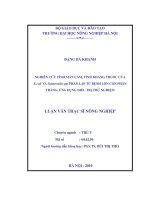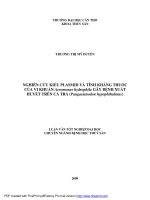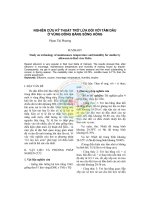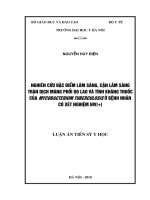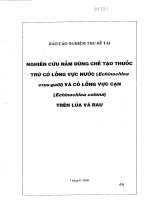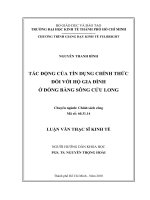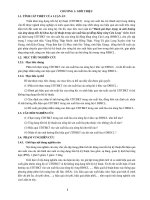Nghiên cứu tính kháng và cơ chế kháng thuốc của cỏ lồng vực nước (echinochloa crus galli) đối với hoạt chất quinclorac tại đồng bằng sông cửu long
Bạn đang xem bản rút gọn của tài liệu. Xem và tải ngay bản đầy đủ của tài liệu tại đây (22.23 MB, 222 trang )
MINISTRY OF EDUCATION AND TRAINING
CAN THO UNIVERSITY
LE DUY
STUDY ON THE RESISTANCE MECHANISM OF
BARNYARDGRASS (Echinochloa crus-galli (L.)
Beauv.) TO QUINCLORAC
IN THE MEKONG DELTA OF VIETNAM
DOCTORAL DISSERTATION
IN PLANT PROTECTION
SUPERVISOR
Assoc. Prof. Dr. NGUYEN MINH CHON
2018
ACKNOWLEDGEMENT
I appreciate all the support from my dissertation supervisor Associate Professor Dr.
Nguyen Minh Chon, Deputy Director of Biotechnology Research and Development
Institute, Can Tho University, and my mentor Dr. Richard K. Mann, Research Fellow
of Dow AgroSciences, Dr. Chon and Dr. Mann are the two scientists who have been
restlessly supporting my career and always provide the valuable advice for this
dissertation.
I am grateful to all of all fellows and friends with whom I have worked together in this
projects. I do appreciate Mr. Nguyen Tan Thuan and Ms. Tran Thi Lai who helped on
the seed collections and the data collection, also Mr. Ngo Thanh Phu who greatly helps
to format the document. Dr. Yerkes, Dr. Cicchillo, Staci, Dave, Debbie and Bill of
Discovery Center, Dow AgroSciences, the dissertation will never be done without your
expertise, my sincere appreciation to all of you.
This dissertation would not have been done without Dr. Hutchin, Dr. Bobba, Dr.
Masters and Sir. Taylor. Your behind the scene support are unmeasurable.
And I would never be able to accomplish my goals without my family.
Tien Giang,…………………….
Le Duy
i
TÓM TẮT
Đề tài được thực hiện nhằm nghiên cứu về tính kháng thuốc cỏ của cỏ lồng vực
(Echinochloa spp.) trên ruộng lúa, 78 mẫu hạt cỏ lồng vực đã được sưu tập từ 7 tỉnh ở
Đồng bằng sông Cửu Long (ĐBSCL). Các nghiên cứu trong luận án tìm thấy các quần
thể cỏ lồng vực kháng thuốc cỏ thuộc nhóm ALS (bispyribac và penoxsulam) và nhóm
thuốc cỏ auxin tổng hợp (quinclorac), giá trị LD90 trung bình của bispyribac,
penoxsulam và quinclorac lần lượt là 33,1; 15,1 và 550,2 g/ha. Kết quả thử nghiệm của
thuốc trừ cỏ rinskor trên các quần thể cỏ lồng vực kháng thuốc cho thấy các quần thể
kháng thuốc trên đều mẫn cảm với rinskor.
Kết quả phân tích kiểu hình cỏ lồng vực trong luận văn cho thấy có 3 nhóm cỏ
chính tương ứng với 3 loài cỏ lồng vực tại ĐBSCL là Echinochloa crus-galli,
Echinochloa oryzoides và Echinochloa erecta, trong đó cỏ lồng vực nước
(Echinochloa crus-galli) là loài phổ biến nhất. Nhằm làm rõ hơn về đa dạng di truyền
trong quần thể cỏ, phương pháp Random amplified polymorphic DNA (RAPD) đã
được dùng để phân tích di truyền của 13 quần thể tại Việt Nam và 2 quần thể cỏ tại
Mỹ. Kết quả cho thấy 6 đoạn mồi oligonucleotide cho kết quả 46 băng đa hình trong
15 quần thể, khoảng cách di truyền của các quần thể trong cây phả hệ là 0,09 đến 0,39.
Kết quả của phân tích di truyền bằng phương pháp RAPD giúp khẳng định mức độ đa
dạng di truyền cao trong quần thể cỏ lồng vực tại ĐBSCL, nhiều loài bị nhầm lẫn với
nhau do rất giống nhau về kiểu hình.
Nhằm làm rõ cơ chế kháng thuốc quinclorac của cỏ lồng vực nước
(Echinochloa crus-galli), nghiên cứu đã tập trung tìm hiểu mức độ phiên mã của gen
và mức độ hoạt động của enzym β-cyanoalanine synthase (CAS) trong lá của 5 quần
thể cỏ và lúa sau khi xử lý thuốc. Kết quả cho thấy ở thời điểm 1 giờ sau khi phun
quinclorac, các quần thể kháng thuốc (R) có thể đẩy nhanh quá trình phiên mã và
chuyển hóa thành enzyme CAS, tốc độ của quá trình này nhanh hơn so với các quần
thể mẫn cảm (S). Ở thời điểm
3 ngày sau xử lý , mức độ phiên mã của gene CAS trong các quần thể R giảm về mức
khác biệt không có ý nghĩa so với đối chứng, tuy nhiên mức độ hoạt động của enzyme
CAS vẫn ở mức cao so với đối chứng và quần thể S.
Từ khóa: cỏ lồng vực, cyanoalanide synthase, kháng thuốc cỏ, RAPD,
ii
SUMMARY
The aim of this dissersation was to study the herbicide resistance of the
barnyardgrass (Echinochloa spp.) in 7 provinces of the Mekong Delta of Vietnam,
seventy-eight seed samples of Echinochloa spp. collected from rice field for the study.
The results found the ALS-resistant and synthetic auxin-resistant E. crus-galli were
confirmed at several locations in the Mekong Delta. The average LD90 value of
bispyribac, penoxsulam and quinclorac for assessed weed populations was 33.1, 15.1
and 550.2 g a.i/ha respectively. The new herbicide rinskor was tested in weed
populations exhibited resistance to current herbicides, results showed that the
Echinochloa populations resistant to bispyribac, penoxsulam and quinclorac were
susceptible to the rinskor under greenhouse test.
The morphology analysis indicated there are 3 main groups that corresponding
to 3 species of Echinochloa crus-galli, Echinochloa oryzoides and Echinochloa erecta
found in Mekong Delta, the Echinochloa crus-galli was the most popular species
identified in the study, to extend the study, we used random amplified polymorphic
DNA (RAPD) analysis and greenhouse testing to study the genetic diversity of 15
Echinochloa populations in the Mekong Delta, Vietnam, and the state of Arkansas,
U.S. Six oligonucleotide primers produced 46 bands were polymorphic among
the 15 populations. The cluster analysis separated the 15 populations into 2 main
clusters with the genetic distances within the clusters ranging from 0.09 to 0.39. The
results of RAPD are useful to confirm the high diversity of Echinochloa spp.
populations in Mekong Delta of Vietnam, many Echinochloa species with similar
morphology could be confused with the others.
To focus on the mechanism of quinclorac resistance in barnyardgrass
(Echinochloa crus-galli), the research have investigated the transcript and activity of
enzyme β-cyanoalanine synthase (CAS) in leaf tissue of 5 barnyardgrass populations
and rice. One hour post quinclorac treatment, R populations were able to rapidly utilize
CAS transcript to possibly fuel increased CAS protein activity, this process is
significantly higher than the process in S populations. Three days following quinclorac
treatment, the utilization effect on CAS transcript levels had ceased, however, CAS
protein activity remained higher in every population compared to non-treated controls
and S populations.
Keywords: Echinochloa, cyanoalanine synthase, Herbicide resistance, RAPD
iii
STATEMENT ON ACADEMIC INTEGRITY
The results presented in this dissertation is the sole effort of the author, except
where explicitly stated. All references related to the studies are acknowledged and
properly cited. All of data and research results in this document are not published in
publications of any different authors.
Ph.D Student
iv
TABLE OF CONTENTS
Page
SUMMARY ................................................................................................................... iii
TABLE OF CONTENTS.................................................................................................v
CHAPTER 1.................................................................................................................1
INTRODUCTION........................................................................................................1
1.1
Problem statement ..........................................................................................1
1.2 Targets of dissertation.........................................................................................2
1.3 Studied objectives and limitation of dissertation ...............................................2
1.4 Major research of dissertation ............................................................................2
1.5 Contributions of dissertation ...............................................................................3
CHAPTER 2.................................................................................................................4
LITERATURE REVIEW.............................................................................................4
2.1 Overview of the Mekong Delta in Vietnam and rice cultivation .......................4
2.2 Definitions of weed and herbicide resistance .....................................................5
2.3 Overview of Echinochloa spp. in the rice field ..................................................8
2.4. Herbicide for barnyardgrass control ................................................................10
2.4.1 Overview of herbicidal active ingredient bispyribac.....................................10
2.4.2 Overview of herbicidal active ingredient penoxsulam ...............................11
2.4.3 Overview of herbicidal active ingredient quinclorac .................................13
2.5 Herbicide resistance and testing methods .........................................................15
2.5.1 The importance of herbicide resistance management.................................15
2.5.2 Target site resistance...................................................................................17
2.5.3 Non target site resistance ............................................................................19
2.5.4 Multiple herbicide resistance ......................................................................23
5
2.5.5 Popular testing methods for herbicide resistance ..........................................24
2.6 Herbicide resistance management strategy ..........................................................31
2.6.1 Minimize weed seed dispersal .......................................................................31
2.6.2 Crop rotation ..................................................................................................31
2.6.3 Herbicide rotation and herbicide mixture ......................................................31
2.7 Reported mechanism of herbicide resistant barnyardgrass (Echinochloa crusgalli).............32
2.7.1 Herbicide resistance research in Echinochloa spp. .......................................32
2.7.2 Enhancement of β-CAS synthase (detoxification of cyanide) in quinclorac
resistance in Echinochloa spp.................................................................................34
2.7.3 Modification in the transduction pathway of auxin reception-signal in R and
S Echinochloa plant ................................................................................................36
2.7.4 Other factors associated to the resistance mechanisms to quinclorac in
barnyardgrass ....36
2.7.5 Herbicide resistance via pollen mediated gene flow in barnyardgrass..........37
CHAPTER 3...............................................................................................................37
MATERIALS AND METHODS ...............................................................................37
3.1 Conceptual framework diagram .......................................................................37
3.2 Materials ...........................................................................................................38
3.3 Research methods .............................................................................................42
3.3.1 Survey on farmer practice in rice cultivation and weed management in the
Mekong Delta .........................................................................................................42
3.3.2 Classification of the collected Echinochloa spp. populations based on plant
characteristics..........................................................................................................43
3.3.3 Evaluate the herbicide-resistance level in collected Echinochloa spp.
populations to 3 active ingredients of bispyribac-sodium, penoxsulam and
quinclorac by dose-response screening method ...................................................44
6
3.3.4 Evaluate the efficacy of rinskor as new herbicide in herbicide resistance
barnyardgrass populations ......................................................................................47
7
3.3.5 Compare the activity of enzyme β-cyanoalanine (CAS) in quincloracsusceptible and quinclorac-resistant barnyargrass plant to study biochemical
mechanism of quinclorac-resistance in barnyardgrass ...........................................47
3.3.6 Identify genetic variation among quinclorac-resistant and quincloracsusceptible Echinochloa crus-galli populations in the Mekong Delta ...................49
3.3.7 Measure mRNA expression level of CAS gene in quinclorac-resistant and
quinclorac-susceptible barnyardgrass .....................................................................52
CHAPTER 4...............................................................................................................57
RESULTS AND DISCUSSION ................................................................................57
4.1 Herbicide application practice and weed management in rice field at Mekong
Delta.........57
4.1.1 Rice cultivation practice .............................................................................57
4.1.2 Important weed species in the rice field at seven provinces of the Mekong
Delta ........................................................................................................................59
4.1.3 Weed management by hand weeding ............................................................60
4.1.4 Weed escaped controlling and the cost on weed management in the Mekong
Delta...........62
4.2 Morphology and distribution of Echinochloa spp. in the Mekong Delta ............64
4.2.1 Plant characteristics .......................................................................................64
4.2.2 Correlation between biological characteristics of Echinochloa plants..........67
4.2.3 Distribution of Echinochloa spp. in the Mekong Delta .................................69
4.3 Herbicide resistant Echinochloa spp. in the Mekong Delta.................................71
4.3.1 Distribution of herbicide resistant Echinochloa spp. in 7 provinces of Mekong
Delta ........................................................................................................................71
4.3.2 Herbicide resistance in three weed groups ....................................................72
4.3.3 The solo resistance and multiple resistance in Echinochloa spp.
populations.................73
4.3.4 Evaluate multiple herbicide resistance level by resistance score ..................75
vii
4.3.5 Impact of field size to resistance score under different water management
conditions .......76
4.3.6 Correlation between field size and hand weeding .........................................77
vii
4.3.7 The impact of hand-weeding to herbicide resistance of Echinochloa spp. in
the Mekong Delta....................................................................................................78
4.4 Weed control efficacy of rinskor in Echinochloa spp. in the Mekong Delta ......80
4.4.1 Control efficacy of rinskor as a new herbicide against three Echinochloa spp.
groups collected in the Mekong Delta ....................................................................80
4.4.2 Control efficacy of rinskor as new herbicide against Echinochloa spp.
populations collected in Mekong Delta ..................................................................81
4.4.3 Correlation between resistance level of bispyribac, penoxsulam and quinclorac
............82
4.4.4 Efficacy of bispyribac, penoxsulam and quinclorac in susceptible E. crusgalli
compared to resistant plants....................................................................................84
4.4.5 Efficacy of rinskor for control of susceptible or resistant barnyardgrass to
bispyribac, penoxsulam and quinclorac..................................................................86
4.5 Biodiversity study by RAPD analysis in 15 barnyardgrass populations from
Vietnam and the U.S ..................................................................................................87
4.5.1 RAPD analysis of 15 barnyardgrass populations ..........................................87
4.5.2 The genetic diversity of Echinochloa crus-galli and herbicide resistance level
............92
4.6 Biochemical mechanism and molecular mechanism of quinclorac resistance in
barnyardgrass .............................................................................................................95
4.6.1 B-CAS activity in 5 quinclorac resistant barnyardgrass populations ............95
4.6.2 CAS transcript abundance in leaf tissue of five barnyardgrass populations
...................97
4.6.3 Biochemical and molecular mechanism of quinclorac resistance in
Echinochloa crus-galli in Mekong Delta ...............................................................99
CHAPTER 5.............................................................................................................101
CONCLUSIONS AND RECOMMENDATIONS ..................................................101
5.1 Conclusions.....................................................................................................101
5.2 Recommendations...........................................................................................102
8
REFERENCES ............................................................................................................103
9
LIST OF TABLES
Page
10
Table 3.1 List of primers were used for RAPD analysis in the research ....................51
Table 3.2 Steps in PCR reactions ................................................................................53
Table 3.3 RT-qPCR primer sequence detecting β-CAS and β-Actin synthase .......... 53
Table 4.1 Rice cultivation practice of farmer in Mekong Delta................................. 58
Table 4.2 Farmer perception about important weed species in rice field at 7 provinces
of Mekong Delta ......................................................................................................... 59
Table 4.3 Farmer response about most escaped weed after herbicide treatments and
need hand-weeding to control .................................................................................... 61
Table 4.4 The three most popular herbicides for escaped Echinochloa spp. control in
Mekong Delta ............................................................................................................. 62
Table 4.5 The cost for weed management in Mekong Delta...................................... 63
Table 4.6 Plant characteristic of Echinochloa spp. collected in Mekong Delta......... 65
Table 4.7 Distribution of Echinochloa species in Mekong Delta .............................. 70
Table 4.8 Herbicide-resistance level in populations to bispyribac, penoxsulam and
quinclorac in different provinces ................................................................................ 71
Table 4.9 Percent of solo-resistance and multiple-resistance herbicides in three groups
of Echinochloa spp. .................................................................................................... 74
Table 4.10 Percent of barnyardgrass population resistant to single and multiple
herbicides of bispyribac, penoxsulam and quinclorac in different provinces ............
75
Table 4.11 Resistance Score of bispyribac, penoxsulam and quinclorac herbicideresistance of 78 Echinochloa spp. populations........................................................... 76
Table 4.12 Average LD90 of 3 Echinochloa groups to bispyribac, penoxsulam,
quinclorac and rinskor ................................................................................................ 81
Table 4.13 Average LD90 of barnyardgrass population to bispyribac, penoxsulam,
quinclorac and rinskor ................................................................................................ 82
Table 4.14 Six informative primers in RAPD analysis of Echinochloa crus-galli
populations.................................................................................................................. 84
Table 4.15 Lethal dose of quinclorac needed to kill 90% of the population (LD 90) and
the Resistance level of 15 Echinochloa crus-galli populations collected in Vietnam
and U.S ....................................................................................................................... 85
11
Table 4.16 Mortality of herbicide susceptible (S) and herbicide resistant (R)
barnyardgrass treated by rinskor at different dose ..................................................... 86
Table 4.17 Six informative primers in RAPD analysis of Echinochloa crus-galli
populations.................................................................................................................. 88
Table 4.18 Lethal dose of quinclorac needed to kill 90% of the population (LD 90) and
the Resistance level of 15 Echinochloa crus-galli populations collected in Vietnam
and U.S ....................................................................................................................... 93
12
LIST OF FIGURES
Page
13
Figure 2.1 Soil distribution map of Mekong Delta....................................................... 5
Figure 2.2 Echinochloa crus-galli flower at mature stage ........................................... 9
Figure 2.3 Infestation of Echinochloa crus-galli in rice field of Long An province, July
2016 ... 9
Figure 2.4 Chemical structure of bispyribac .............................................................. 10
Figure 2.5 Process of manufacturing penoxsulam from N-(triazolo[1,5-a]pyrimidine)
sulfonamides ............................................................................................................... 12
Figure 2.6 Molecular structure of quinclorac ............................................................. 13
Figure 2.7 Chronological increase in Resistant Weeds Globally ...............................
16
Figure 2.8 GST-catalyzed detoxification of atrazine in plants................................... 21
Figure 2.9 The minimal ABC transporter has four domains. Two transmembrane
domains (TMDs) bind ligand, and transport is driven by ATP binding and hydrolysis
by the two nucleotide binding domains (NBDs) .............................................................
23
Figure 2.10 Plant nursery for herbicide screening test ............................................... 26
Figure 2.11 Results of herbicide screening in different weed populations ................ 26
Figure 2.12 Dose response curves for a Susceptible (S) and a Resistant (R) population
............ 27
Figure 3.1 The workflow designation ........................................................................ 38
Figure 3.2 The map of sampled barnyardgrass .......................................................... 40
Figure 3.3 Prepare the barnyardgrass seedling for herbicide screening .....................
41
Figure 3.4 Symptom of bispyribac in barnyardgrass leaf .......................................... 45
Figure 3.5 Symptom of penoxsulam in barnyardgrass leaf ........................................
46
Figure 3.6 Symptom of quinclorac in barnyardgrass leaf .......................................... 46
Figure 3.7 Symptom of rinskor in barnyardgrass leaf ................................................
46
Figure 3.8 Ninety-six wells microplate for the spectrophotometer reading at wavelength
650Å.......49
Figure 3.9 β-CAS gene mined from the in-house ECHCR transcriptome ................. 54
14
Figure 4.1 Mosaic plot diagram of hand-weeding practice after herbicide application in
71 survey fields in Mekong Delta .............................................................................. 60
Figure 4.2 Flowers of three Echinochloa spp. groups in the study ............................ 66
15
Figure 4.3 Correlation between plant height and shoot dry weight of three Echinochloa
group ........................................................................................................................... 67
Figure 4.4 Correlation between panicle emerged date and grow duration of three
Echinochloa groups .................................................................................................... 68
Figure 4.5 Resistance level of three Echinochloa groups to bispyribac, penoxsulam and
quinclorac in different provinces ................................................................................ 73
Figure 4.6 Correlation between Resistance Score and field size under different water
management conditions .............................................................................................. 77
Figure 4.7 One way ANOVA t-test for field size and hand-weeding practice .......... 78
Figure 4.8
One way ANOVA t-test for the impact of hand-weeding to herbicide
resistance in rice field ................................................................................................. 79
Figure 4.9 Correlation between LD90 value of herbicides in barnyardgrass ......................
83
Figure 4.10 Electrophoresis image of 6 primers produced polymorphic bands......... 89
Figure 4.11 The dendrogram of 15 Echinochloa crus-galli populations from Vietnam
(CT-10, KG-01, TG-03, HG-06, HG-02, CT-08, HG-03, CT-04, VL-03, HG-01, CT02, CT-01, VL-01) and U.S (A-S, AR) ............................................................................
90
Figure 4.12 Geographic distribution of 13 Echinochloa crus-galli populations collected
in the Mekong Delta, Vietnam ................................................................................... 91
Figure 4.13 Mode of action of quinclorac in E. crus-galli and the process to measure
the activity of CAS after quinclorac treatment.................................................................
95
Figure 4.14 LD50 and % Mortality of 5 barnyardgrass populations foliar-treated by
quinclorac ................................................................................................................... 95
Figure 4.15 Activity of enzyme CAS (nmol H2S/100ug/minute) in barnyardgrass leaf
tissue treated by quinclorac.. ...................................................................................... 97
Figure 4.16
CAS transcript abundance was significantly decreased 1 hour after
quinclorac treatment in resistant populations Ech_03, Ech_04, Ech_05 and Oryza sativa
however,
remained unchanged
in
susceptible populations
................................................ 98
xii
Ech_01
and
Ech_02
Figure 4.17 Three days following quinclorac treatment, CAS transcript abundance was
not significantly different than the non-treated controls in all populations except for
Ech_02 where data is unavailable .............................................................................. 99
xii
LIST OF ABBREVIATIONS
ALS
Acetolactate synthesis
ACCase
Acetyl CoA Carboxylase
CAS
Cyanoalanide synthase
LD90
Lethal Dose of 90% of population
PCR
Polymerase Chain Reaction
RAPD
Random Amplified Polymorphic DNA
RT-qPCR
Real-time Polymerase Chain Reaction
xiii
CHAPTER 1
INTRODUCTION
1.1 Problem statement
According to Moody (1988) weed competition in flooded rice fields
might decrease grain yield by 25%. In several cases, uncontrolled weeds on
dry direct- seeded rice could impact up to 50% yield loss on rice (Chauhan,
2012). To date, approximately 388 biotypes of 210 species that showed
resistance to herbicides had been documented (Caseley et al. 2013). Among
key weeds in the field, the barnyardgrass (Echinochloa crus-galli) had been
considered as the most notorious for a long time, as a C4 plant, the growth rate
of barnyardgrass is far dominant to rice (Caton et al. 2004). In addition,
Echinochloa crus-galli and Echinochloa colona can mimic the rice appearance
at the early stage of weed seedlings, the similarity in plant appearance make it
hard to control by hand weeding (Chauhan, 2012).
Herbicides still play an important role as the most effective method in
weed management on rice fields, however, herbicide resistance is an certain
issue. From 1994 to 2014, the number of herbicide resistance cases on rice
culture is 32 species in 25 countries and 8 Mode of Action (MoA) groups.
Among 127 reports over the world, 43 instances were reported on
barnyardgrass (Echinochloa spp.), in which, 12 out of 43 cases resisted to
group B (Acetolactate synthase inhibitors) and 7 out of 43 cases resisted to
group O (Synthetic auxins). These reports also included one case that resisted
to both MoA groups (Heap, 2014).
The barnyardgrass could evolve resistance to several current herbicide
active ingredients, especially to two groups of B and O. In this situation,
further research about herbicide resistance in barnyardgrass is critical. In
recent years, there are many methods to study herbicide resistance including
bioassay with screening and DNA analysis, such as Rapid Whole-Plant
Assay for Post- Applied Herbicides, Seed Germination Assays, Agar-Based
Seedling Assays, Leaf Disc Assays, Pollen Germination Test, DNA-Based
Assays (Burgos et al.,
2013).
Today herbicide testing methods exhibit particular advantages and
disadvantages. For multiple study purposes, a single or combination of several
methods could be utilized. Based on targets of research, Rapid Whole-Plant
Assay for POST-Applied Herbicides and Seed Germination Assays would be
suitable to identify the herbicide resistance level of weed, and DNA-Based
Assays would be appropriate to detect the resistant gene in weed biotypes. As
1
an outcome, the dissertation of “Study on the resistance mechanism of
barnyardgrass (Echinochloa crus-galli) to quinclorac in the Mekong Delta of
Vietnam” was proposed.
1.2 Targets of dissertation
Evaluate the morphological variability and genetic diversity of
Echinochloa spp. populations in Mekong Delta of Vietnam.
Evaluate the herbicide-resistance level of Echinochloa spp. to bispyribac,
penoxsulam and quinclorac in rice fields at the Mekong Delta of Vietnam.
Explain the biochemical mechanism and the molecular mechanism of
quinclorac-resistance in Echinochloa crus-galli.
1.3 Studied objectives and limitation of the dissertation
This study is limited to rice fields in the 7 provinces of Mekong Delta of
Vietnam (Long An, Tien Giang, Vinh Long, Can Tho, An Giang, Hau Giang
and Kien Giang).
The targeted weed in the study is Echinochloa spp., the weed was
examined for herbicide-resistance evaluation and mapping purpose. The
Echinochloa crus-galli is main species studied for quinclorac-resistance
mechanisms at the biochemical and molecular level.
1.4 Major research topics of the dissertation
(1) Survey the rice cultivation and weed management practice in rice
fields at the Mekong Delta of Vietnam.
(2) Evaluate the diversity of Echinochloa spp. population in rice fields at
the Mekong Delta of Vietnam.
(3) Evaluate the herbicide-resistance level of the collected Echinochloa
spp. samples to bispyribac-sodium, penoxsulam and quinclorac by doseresponse screening method.
(4) Evaluate the efficacy of rinskor, a new herbicide against the
herbicide- resistant Echinochloa crus-galli to find new effective herbicide for
current herbicide-resistant barnyardgrass.
(5) Use RAPD analysis to evaluate the genetic diversity of Echinochloa
crus-galli populations, and the correspondence of quinclorac-resistance and
genetic distance of Echinochloa crus-galli populations in the Mekong delta
(6) Measure the activity of β-cyanoalanine synthase in the leaf tissue of
Echinochloa crus-galli to study the biochemical mechanism of quincloracresistance in barnyardgrass.
2
(7) Measure the expression level of mRNA of CAS gene in barnyardgrass
to study the molecular mechanism of quinclorac-resistance in barnyardgrass.
1.5 Contributions of dissertation
This research presents useful information about the diversity of
Echinochloa spp. in the rice field of Mekong Delta of Vietnam (Mekong
Delta), which will be important for further study about this weed species.
The most important result of this study is data about the herbicideresistance of Echinochloa spp., the research has confirmed the existence of
herbicide-resistant Echinochloa spp. populations in Mekong Delta. This
research also evaluates the relationship between farmers’ weed management
practice and the herbicide-resistance, therefore, the practical solutions for
herbicide-resistant weed were also determined and suggested in the
dissertation.
The mechanisms of quinclorac-resistance in barnyardgrass were
confirmed and elucidated at enzyme and molecular level, through the
measurement of quinclorac detoxifying enzyme activity and its gene
expression level in barnyardgrass. The results establish important information
for the further study about the mechanism of the herbicide-resistance in weeds.
3
CHAPTER 2
LITERATURE REVIEW
2.1 Overview of the Mekong Delta in Vietnam and rice cultivation
Vietnam is one of the top rice exporters globally. In 2015, about 45
million tons of rice was produced in Vietnam, of which 22.4% was exported,
and the remaining was for domestic consumption (USDA, 2017). For several
years, rice is one of the most important crops in Vietnam with approximate 7.6
million hectares cultivated in the country (General statistics office of Vietnam,
2017). Moreover, about 55% of rice in the country was grown in the Mekong
Delta, and the average yield of this region was 5.96 ton/ha (General statistics
office of Vietnam, 2017) which was 38% higher than the global average yield
(FAOSTAT, 2017).
Mekong Delta, Vietnam is an area of 40,577 km2. This is the most
downstream part of the Mekong River, the total population is over 17 million
with 3.96 million hectares for agriculture activities (Le Anh Tuan et al., 2007).
Mekong Delta produces more than 50% of cereal food for all of Vietnam. Rice
exportation from this area is one of the most important income for the country,
54% of rice in the Delta was cultivated during the Summer-Autumn season
(May to August); resulted in the highest yield harvested during Winter-Spring
season (January to April), which could be 20.5% higher than average of the
year (Nguyễn Hoàng Dân et al., 2015).
Average field size per household in the Mekong Delta is 1.29 ha, higher
than average size in the country which is 0.44 ha. Although the area of rice
growing has reduced since 1980, the rice farming system now changes to an
intensification model, in 2010 there was 530,000 ha growing rice in triple
crops per year compared to 23,000 ha in 1980 (Nguyễn Đức Thành và Đinh
Tuấn Minh, 2015). The average cost of pesticide per season in this area was
17-20% (Hồ Cao Việt, 2011).
The Mekong Delta natural condition is divided by 12 soil types (Fig 2.1),
and their distribution influences the local agricultural activities and rice
production (Minh, 2002). 80% of the total surface water used for rice growing
areas, the intensive rice growing areas are located in upstream and midstream
provinces (Dang Kieu Nhan et al., 2007).
In recent year, water shortage and the saline water intrusion are one of the
major threats for rice cultivation in Mekong Delta. Saline water could intrude
far into the irrigation system of many provinces in the dry season of 2016,
4
